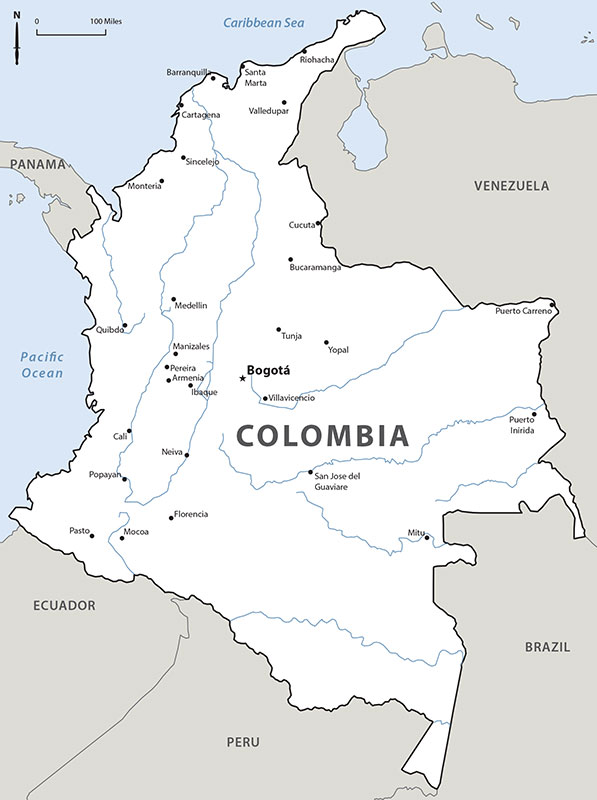DOWNLOAD
This special campaign issue of Veritas is devoted to Army Special Operations Forces (ARSOF) in Colombia. The nation of Colombia has a unique and long-standing relationship with the United States dating from the Korean War. Today, both nations are united in an effort to counter the problem of narco-terrorism as part of America’s Global War on Terrorism. The purpose of this issue is to present the historical background of that long-term relationship, describe the Colombian military and police forces and their overseas experiences, provide an overview of the U.S. military commitment in Colombia, explain what ARSOF soldiers are doing in Colombia, and discuss improvised explosive devices (IEDs).
The issue opens with a description of the special relationship between the United States and Colombia, one that dates from the U.S. recognition of the newly independent nation in 1822. The country’s modern history, specifically post–World War II internal problems associated with La Violencia and the regeneration of insurgent groups (rural and urban) while the illegal drug trade was expanding, are addressed in the article. The theme of internal strife, most notably La Violencia, which periodically recurs throughout Colombia’s modern period, plays a prominent role in all aspects of Colombian life. One very positive experience during the post-war years was the performance of the Colombian military in the Korean War.

The Colombian Army formed and deployed the Batallón Colombia while the Navy rotated a frigate to fight alongside the United Nations forces in Korea. The Batallón Colombia fought valiantly with the 24th and 7th Infantry Divisions in numerous engagements and was involved in the brutal fight for Old Baldy in March 1953. Colombian Navy frigates bombarded and blockaded the Korean Peninsula. Combat in Korea was a seminal event for Colombian officers that led to the professionalization of the armed forces. Following the Korean War, two U.S. Army officers were instrumental in the establishment of the Colombian Lancero School, the oldest Ranger course in Latin America. The more than fifty years of American military professional exchanges and the increased numbers of such exchanges are indicative of Colombia’s importance to U.S. strategic interests in Latin America.
The commander of the U.S. Army Special Warfare Center, Brigadier General William P. Yarborough, visited Colombia and provided recommendations that were incorporated in Plan Lazo (lasso) designed to eliminate the violence caused by bandits and quasi-guerrillas in the countryside. The recurrent themes espoused in Plan Lazo are still relevant and are important to understand Colombia today. Plan Lazo pre-dated the modern-day Plan Colombia, the heavily U.S.-funded national campaign to rid the country of the narco-terrorists. Plan Colombia and its successor Plan Patriota are explained before the “enemy order of battle”—the insurgent groups. An overview of the Colombian armed forces, both military and police, constitutes the “friendly order of battle.” Colombian Special Operations Forces (SOF), supported by the U.S. ARSOF “economy-of-force” approach, are treated separately. The Colombian National Police, an integral part of the Ministry of Defense, and its close relationship with the military in the fight to counter narco-terrorism is a third theme that is prevalent in this issue. U.S. forces who work with both security forces must continually deal with the complexities of this integration.
The U.S. SOF mission originates with the U.S. Southern Command (SOUTHCOM) and is executed by Special Forces ODAs (operation detachment alphas) of the 7th Special Forces Group, the Psychological Operations elements from the 4th Psychological Operations Group, and the 95th Civil Affairs Brigade teams who advise and train Colombian Army and National Police paramilitary units and assist national assets. Topics covered explain what the ARSOF soldiers are doing, training-wise, in Colombia with SOF, National Police, and, in the case of the conventional divisions and brigades, what planning assistance and training teams (PATTs) do in support of the counter-insurgency campaign. The soldier history articles are based on the perspectives of the ARSOF teams and are largely told in their own words. The issue then returns to the Colombian Army.
The Colombian Army has a long history of peacekeeping in the Sinai that dates to 1956. This commitment to international security operations stems from the Korean War experience. It demonstrates Colombia’s commitment to collective security and international peace. The issue concludes with an article on IEDs, the overwhelming cause of U.S. military casualties in Afghanistan and Iraq. IEDs are a major problem in Colombia, now third in the world for landmine victims.
Three major themes run through this issue and are crucial to understanding Colombia. They are the impact of La Violencia, in its several forms over almost sixty years on the people and country, a military solution alone is insufficient to restore law, order, and confidence in the democratic government; and the relationship with the United States is tightly entwined with the counter-drug war and the growing threat of regional terrorism. In Colombia, the United States has a partner that is willing to pursue a national internal defense strategy that is in concert with its own.
Articles in this issue
Colombia: A Special Relationship
Forty Years of Insurgency: Colombia’s Main Opposition Groups
Colombian Special Operations Forces
Plan Colombia and Plan Patriota: The Evolution of Colombia’s National Strategy
U.S. Forces: The Major Command Structure
“Conducting the Orchestra”: AOB 740 in Colombia
“Who taught these guys to shoot like Chuck Norris?” ODA 746 in Tolemaida
“There is a Word I Need to Learn”: ODA 741 and Colombian National Police Training at Espinal
